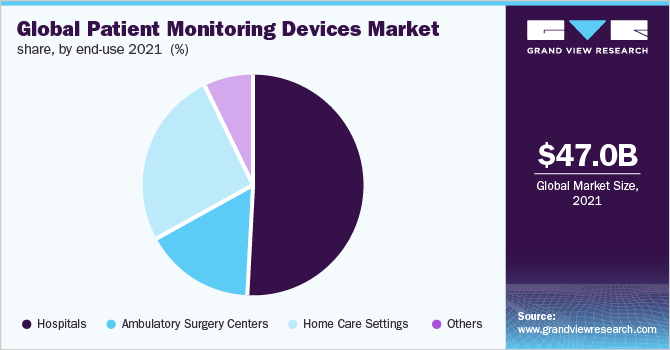The global patient monitoring devices market was valued at USD 51.1 billion in 2022 and is forecasted to grow at a compound annual growth rate (CAGR) of 7.7% from 2023 to 2030. This growth is largely driven by the rising demand for monitoring devices that track, measure, and display various biometric indicators, such as blood pressure, body temperature, and blood oxygen saturation levels.
The shift from hospital-based care to homecare settings has made treatments more affordable. Advances in healthcare technology have accelerated the adoption of patient monitoring devices for home-based management of chronic diseases. The COVID-19 pandemic further supported this shift by giving companies the opportunity to demonstrate how their devices can make healthcare more convenient, cost-effective, and accessible.
Gather more insights about the market drivers, restrains and growth of the Global Patient Monitoring Devices Market
Market Dynamics
Growing Adoption of Remote Patient Monitoring
Over the past few years, there has been a significant increase in the use of remote patient monitoring devices, especially since the COVID-19 pandemic, as they allow continuous tracking and analysis of vital signs. Remote monitoring devices enable healthcare providers to monitor patients’ health outside of traditional healthcare facilities, supporting a more versatile healthcare model. Digitalization in healthcare is also generating new revenue streams and helping to reduce costs. Additionally, these devices support monitoring for non-COVID patients as well.
Increasing Prevalence of Chronic Conditions
The rising prevalence of chronic diseases globally is expected to drive demand for patient monitoring devices. According to the World Health Organization, chronic diseases accounted for approximately 73% of global deaths and 60% of the disease burden in 2020, with developing countries representing 79% of these deaths. Major chronic conditions include cardiovascular diseases, chronic obstructive pulmonary disease (COPD), cancer, and type II diabetes, all of which require ongoing monitoring.
Technological Advancements in Patient Monitoring Devices
In today’s complex healthcare landscape, the need for advanced and accurate monitoring systems is critical as healthcare providers aim to deliver higher-quality services. Patient monitoring technology has evolved from intermittent monitoring to continuous systems, providing clinicians with accurate data for treatment decisions. Hospitals and healthcare providers are increasingly prioritizing reliable data and cost-effective devices, marking a key step toward further technological advancements. Innovations in monitoring devices help clinicians identify high-risk patients more effectively.
End-Use Insights
The hospital segment held the largest market share, accounting for over 51.1% of the revenue in 2022. This dominance is due to the critical need for accurate and timely disease detection in hospitals and the high volume of medical procedures performed there. With increasing hospital admissions due to injuries, chronic illnesses, and other health issues, the use of multiparameter monitors in both general wards and intensive care units has become essential for continuous tracking of vital signs, such as oxygen saturation, respiratory rate, blood pressure, and heart rate.
Other market segments include ambulatory surgical centers, homecare settings, and additional facilities. The homecare segment is expected to grow rapidly over the forecast period. The trend toward portable, next-generation diagnostic, display, therapeutic, and monitoring devices that are more adaptable, precise, and compact is driving the demand for homecare solutions. These advanced devices facilitate treatment delivery at home or at the bedside, supporting the ongoing transition toward at-home healthcare solutions.
Order a free sample PDF of the Patient Monitoring Devices Market Intelligence Study, published by Grand View Research.
